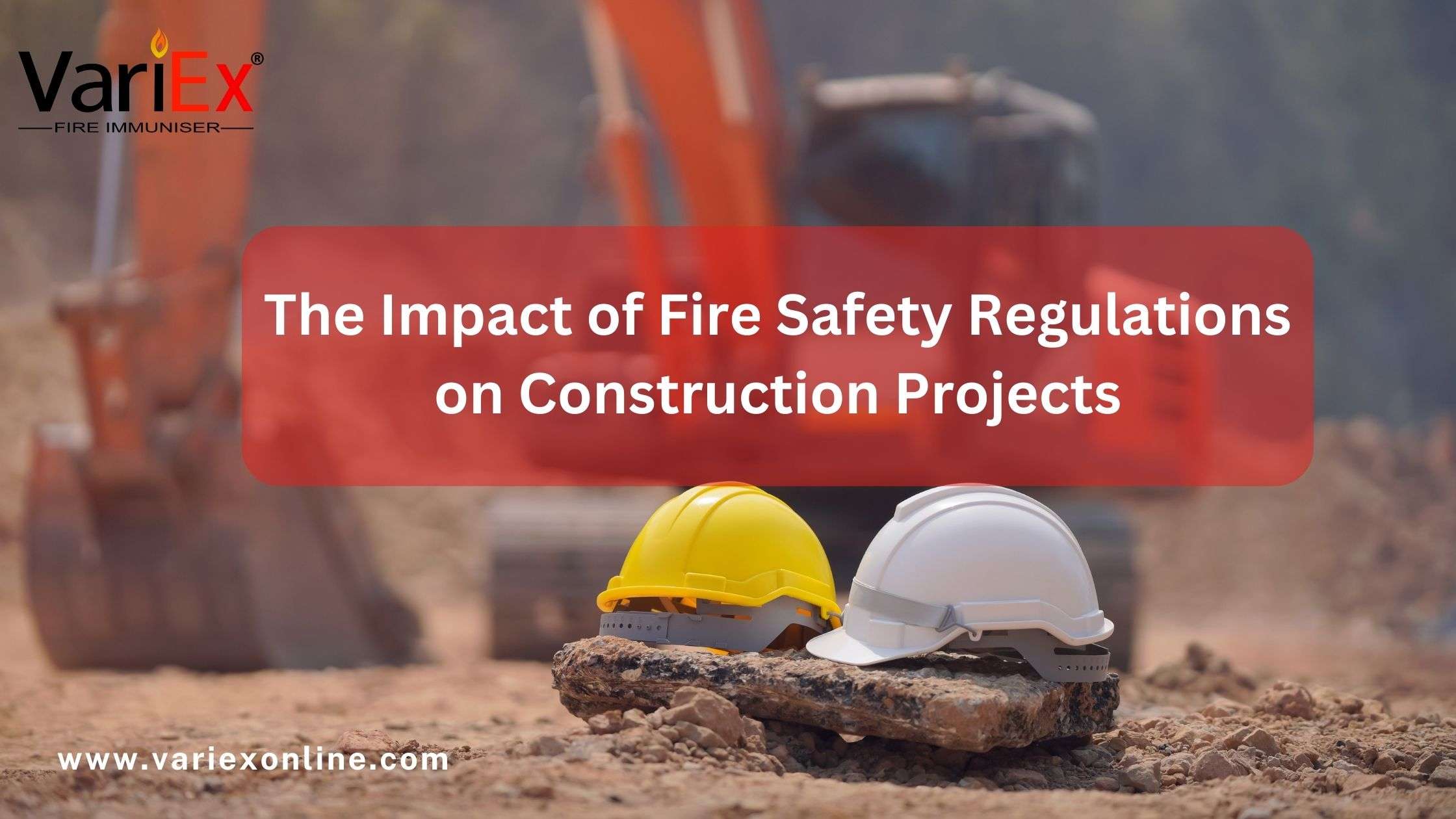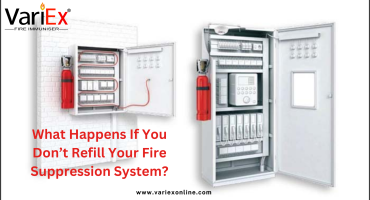![]()
Fire Immuniser
+91-7829629111
Email: info@variex.in
Varistor Technologies Pvt. Ltd.
Block-1, First Floor, Ardente Office One, Hoodi Circle, ITPL Main Road, Bengaluru, Karnataka 560048, IN
The Impact of Fire Safety Regulations on Construction Projects
The Impact of Fire Safety Regulations on Construction Projects
The construction industry is inherently risky, with potential hazards that can endanger lives and property. Fire safety regulations are implemented to mitigate these risks, ensuring that buildings are constructed with the necessary precautions in place. Compliance with these regulations not only enhances safety but also impacts various facets of the construction process, including design, materials, and overall project execution. In this blog, we will delve into how fire safety regulations shape construction projects and why they are vital for ensuring a safe built environment.

Understanding Fire Safety Regulations
Fire safety regulations are guidelines established by local, state, and national authorities to ensure that buildings are constructed, maintained, and operated in a way that minimizes the risk of fire. These regulations often encompass:
- Building codes: Standards that dictate how structures should be designed and built to withstand fires.
- Fire codes: Regulations that address fire prevention, fire protection, and emergency response procedures.
- Occupational safety regulations: Guidelines that protect workers during construction and ensure safe working environments.
Understanding these regulations is essential for construction professionals, as they serve as the foundation for all fire safety measures within a project.
The Role of Building Codes in Fire Safety
Building codes are critical in ensuring fire safety during construction projects. They set minimum safety standards for materials, construction methods, and design features. Key aspects of building codes include:
- Egress Requirements: Codes dictate how many exits a building must have, their locations, and how easily they can be accessed during an emergency.
- Fire Resistance Ratings: These ratings determine how long a building material can withstand fire exposure, affecting the choice of materials used.
- Compartmentation: Building codes often require structures to be divided into compartments to limit the spread of fire and smoke.
Adhering to these building codes is not only a legal obligation but also a best practice for ensuring the safety of occupants and minimizing property damage.
Impact on Construction Design
Fire safety regulations significantly influence the design phase of construction projects. Designers and architects must consider fire safety principles when creating plans. Here are some ways regulations impact construction design:
1. Design Layout
- Open Floor Plans vs. Compartmentalization: Open layouts may be appealing for aesthetic reasons, but fire safety regulations may require compartmentalization to prevent fire spread.
- Exit Routes: The design must include clearly marked and accessible exit routes, which can affect the overall layout and flow of the space.
2. Fire Separation
- Regulations often require certain structures to be separated by fire-rated walls to prevent fire from spreading to adjacent buildings. This can influence site layout and spacing between buildings.
3. Access for Emergency Services
- Building designs must provide adequate access for firefighters and emergency responders, which may influence the building’s location, orientation, and surrounding infrastructure.
By incorporating fire safety regulations into the design phase, construction professionals can create safer environments that comply with legal standards.
Material Selection and Fire Resistance
The materials used in construction play a significant role in fire safety. Regulations often specify which materials can be used based on their fire resistance ratings. Here’s how fire safety regulations impact material selection:
1. Fire-Resistant Materials
- Fire-Resistant Ratings: Materials must meet specific fire resistance ratings, which dictate how long they can withstand exposure to flames. Common fire-resistant materials include concrete, steel, and fire-rated glass.
2. Flammable Materials
- Regulations may limit the use of highly flammable materials in certain areas of a building, such as near exits or in high-occupancy spaces.
3. Sustainable Choices
- Increasingly, fire safety regulations encourage the use of sustainable materials that are also fire-resistant, aligning with broader environmental goals.
Selecting appropriate materials is not only crucial for compliance but also essential for enhancing the overall safety of the constructed environment.
Fire Safety Systems and Technology
Advancements in fire safety technology have transformed how buildings are designed and constructed. Fire safety regulations often mandate the installation of specific systems, including:
1. Fire Detection and Alarm Systems
- Smoke Detectors: Regulations may require smoke detectors in various locations within a building, influencing the design and installation of these systems.
2. Sprinkler Systems
- Many building codes mandate the installation of sprinkler systems in commercial buildings, which can significantly impact construction costs and timelines.
3. Fire Suppression Systems
- These systems are crucial for controlling and extinguishing fires. Compliance with regulations regarding their installation can affect the design and layout of a building.
Integrating these fire safety systems into construction projects not only ensures compliance but also enhances the overall safety of the building.
Compliance and Inspections
Compliance with fire safety regulations is a vital aspect of any construction project. Regular inspections are conducted at various stages of construction to ensure adherence to these regulations. Here’s how compliance impacts construction projects:
1. Permitting Process
- Obtaining permits often requires proof of compliance with fire safety regulations. This can lengthen the approval process but is necessary for ensuring safety.
2. Inspections During Construction
- Building inspectors will check for compliance with fire codes and building regulations at various stages, which can impact construction timelines and schedules.
3. Post-Construction Compliance
- After construction, buildings must pass inspections to ensure ongoing compliance with fire safety regulations. Non-compliance can lead to fines, penalties, or even closure.
Ensuring compliance with fire safety regulations throughout the construction process is essential for the safety of future occupants and for avoiding legal issues.
Challenges in Adhering to Fire Safety Regulations
While fire safety regulations are crucial for protecting lives and property, they can present challenges during construction projects:
1. Cost Implications
- Implementing fire safety measures can increase construction costs, which may impact budgets and project timelines.
2. Complex Regulations
- Navigating the myriad of fire safety regulations can be complex, requiring expertise that may not be readily available within a construction team.
3. Balancing Aesthetics and Safety
- Designers may face challenges in balancing the aesthetic appeal of a building with the requirements of fire safety regulations, leading to potential compromises.
4. Evolving Regulations
- Fire safety regulations can change, requiring builders to stay updated and adapt their practices to remain compliant.
Despite these challenges, prioritizing fire safety is essential for ensuring the long-term success and safety of any construction project.
Conclusion
Fire safety regulations significantly impact construction projects, influencing everything from design and material selection to compliance and inspection processes. Understanding these regulations is vital for construction professionals to ensure the safety of occupants and protect property. By prioritizing fire safety, builders can create safer environments that adhere to legal standards and promote public welfare.
As the construction industry continues to evolve, staying informed about fire safety regulations and their implications will be crucial for ensuring the safety and success of future projects. Ultimately, investing in fire safety measures is not just a legal obligation; it’s a moral responsibility to safeguard lives and property in the built environment.
Frequently Asked Questions
Fire safety regulations protect occupants, property, and investments by ensuring buildings are designed and built to prevent and withstand fires.
Regulations influence design elements such as layout, fire exits, compartmentalization, and emergency access, ensuring safer building structures.
Fire-resistant materials slow the spread of fire, providing critical time for evacuation and fire control, and are often mandated by fire safety regulations.
Common systems include smoke detectors, sprinkler systems, and fire suppression systems, all of which enhance building safety and are often legally required.
Challenges include higher costs, navigating complex regulations, balancing aesthetics with safety, and adapting to evolving standards.
Final Say
At VariEx.in and VariexOnline.com, we specialize in supplying and installing top-quality fire fighting systems and equipment. From fire extinguishers to advanced suppression systems, we offer comprehensive solutions tailored to your needs. Our experienced team ensures precise installation and maintenance for optimal safety.
Trust VariEx for reliable fire protection. Contact us online or call 7829629111 to learn more.
We specialize in manufacturing, supplying, and distributing a comprehensive range of fire fighting equipment, including state-of-the-art fire extinguishers. Read our most searched blogs and find interesting information on topics such as how to use a fire extinguisher, how to calculate fire fighting water tank capacity, fire extinguisher refilling, obtaining a Fire NOC, understanding fire fighting systems, types of fire protection systems, the fire hydrant system, and the fire sprinkler system. These resources provide essential knowledge for ensuring safety and compliance with fire safety regulations. Additionally, you can explore guides on the maintenance of fire protection equipment, the latest advancements in fire safety technology, and best practices for fire risk assessment and management.
Our expertise extends to fire alarm systems, fire hydrant systems, and fire suppression systems, including fire sprinklers. Each product meets rigorous international standards for reliability and performance, ensuring effective fire safety products tailored to diverse applications and industries. Additionally, we are providing Fire Extinguisher Refilling and AMC services to ensure ongoing maintenance and operational readiness of fire safety equipment.
"WHAT YOU CAN READ NEXT"
 Read more +24 November 2023 in Fire Extinguisher
Read more +24 November 2023 in Fire ExtinguisherWhat types of fire extinguishers are available for different fire classes?
 Read more +11 April 2025 in Fire Suppression
Read more +11 April 2025 in Fire Suppression






